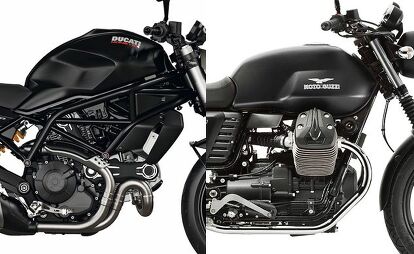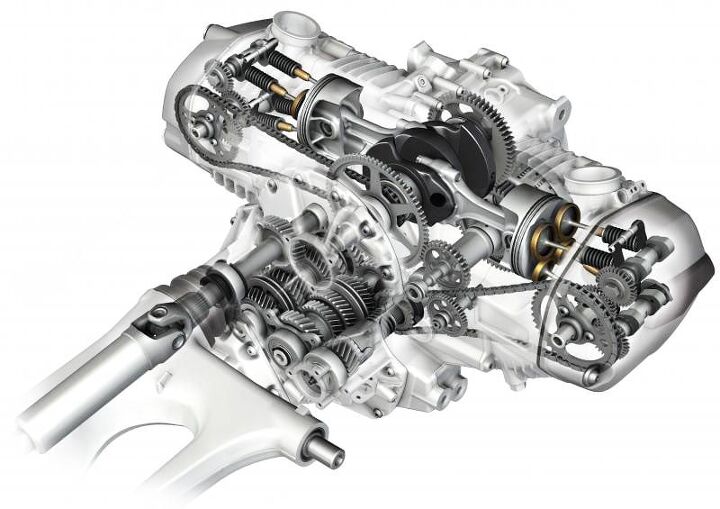As the Crankshaft Turns
Ask MO Anything: Transverse or Longitudinal V-Twin?
Dear MOby,
Excuse the noob question, but what’s the difference between a transverse V-Twin and a longitudinal one, and what are the advantages of each?
Navigational Ade
Dear Ade,
It has to do with the orientation of the crankshaft. Any engine, be it a V-Twin, V-Four, or inline-Four, is considered to be “transverse” if its crankshaft lies perpendicular to the motorcycle’s wheels, i.e. across the frame, parallel to the axles. Most motorcycles have transversely mounted cranks, including all Harley-Davidson V-Twins, nearly all four-cylinder sportbikes like the Yamaha R1, Kawasaki ZX-10R, Aprilia RSV4, all Ducati V-Twins and V-Fours… including the Monster 797 pictured on the left, above.
Chain or belt drive to the bike’s rear wheel is simplest and lightest with this layout, and having the crankshaft spinning in the same plane as the rear wheel means power can be transferred through the gearbox and straight on into the drive chain and rear sprocket without making any power-sucking changes of direction.
I can’t think of any modern racebike that doesn’t use a transverse crankshaft and chain final drive: It’s simple, efficient, light and allows easy sprocket changes to alter gearing for different tracks. The downside is that drive chains and sprockets require maintenance and wear out (a lot less quickly now than before the invention of the sealed O-ring chain).
Chain reliability in the bad old days is why many touring bikes, especially ones that have been around awhile, have longitudinal-crankshaft engines that use a shaft drive to send power to the rear wheel, like an automobile.
The Honda Gold Wing’s six-cylinder Boxer motors also use a longitudinal crank and driveshaft, as well as the defunct Honda ST1300. So do all Moto Guzzis, including the V7 in the right half of the lead image, and so did plenty of vintage bikes. Riders who pack on plenty of miles and don’t want to be bothered to oil their chain, or toss and turn at night worrying about what lube to use, have always been fans of shaft-driven bikes.
Not to say that there aren’t plenty of bikes with transverse cranks and shaft drives, like the Yamaha FJR1300, BMW K1200/1300 series bikes and now the K1600 Six-cylinders. All those bikes must redirect power through two 90-degree bends to get it to the rear wheel, which costs weight and a little bit of power, but those aren’t critical commodities on big touring bikes.
One final thought: Don’t be confused by Moto Guzzi, which totally goes its own way as usual by calling its bikes Transverse Twins in its spec sheets. Those cylinders jutting out on both sides are transverse maybe, but Guzzis all have longitudinal crankshafts passing power into their shaft final drives.
Other advantages and disadvantages of transverse vs. longitudinal could fill more than one book, and have – but these are the basics.
Recent Ask MOs:
Harley-Davidson Roadster or Triumph Bobber?
Why Does My Motorcycle Clunk When I Shift Into First Gear?
Variable Intake Velocity
Send your questions to AskMoAnything@motorcycle.com. Questions are answered by volume, not by weight. Some settling of your answer may occur during shipping and handling. Not responsible for lost or stolen answers, and definitely not responsible for wrong answers, though we’re happy to take the credit if we’re right.
More by John Burns



































Comments
Join the conversation
When they mount and engine in a supercar, it is called "oh" transverse. When you put an engine in an Moto Guzzi (my favorite), it is also "transvers". regardless how the drive shaft goes. What about those "complicated" drive shaft systems in some bikes? Is that a "complicated" engine description?
I was under the impression an engine with a transverley mounted crank and chain drive, like a harley-davidson was the most compact and straight-forward layout just like it says here, but a transversley mounted engine like a bmw or moto-guzzi cooled better, and yet would cause the bike to lean to one side under a lot of power, because of twisting around the crankshaft, while the regular transverse(crank) layout twisted in line with the frame/wheels.